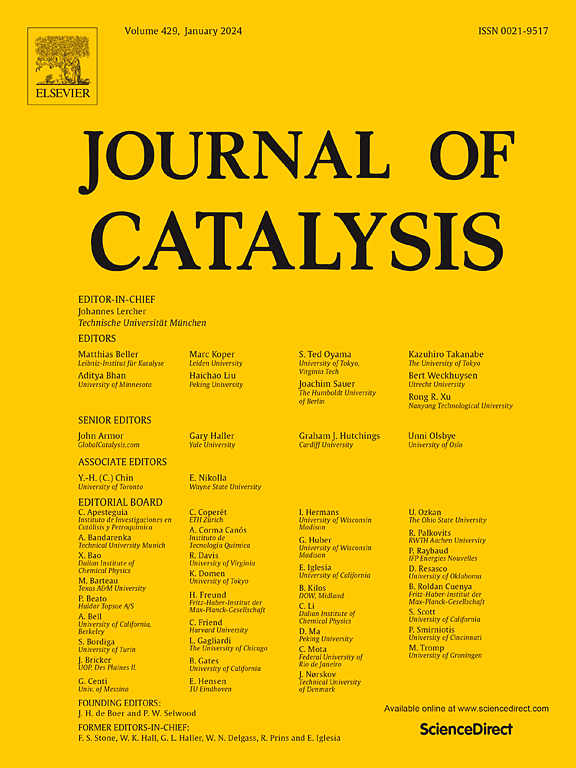Halogen-free and solvent-free CO2 cycloaddition via adjusting the types of surface defect and doped metal on the metal-doped M/AlOOH catalysts
IF 6.5
1区 化学
Q2 CHEMISTRY, PHYSICAL
引用次数: 0
Abstract
The development halogen-free, solvent-free heterogeneous catalysts for CO2 cycloaddition with epoxides remains critical, as conventional homogeneous systems face challenges in product separation and leave halogen residues. This work addresses these limitations by designing a series of halogen-free M/AlOOH catalysts with different types of doped metal M and surface defects, to optimize CO2 cycloaddition with ethylene oxide (EO) by the regulation of acid-base properties. Theoretical and experimental analyses reveal that Lewis acid-base pairs composed of M∙∙∙VH and M∙∙∙VOH could stabilize the ring-opening intermediates (LO/LC) and promote EO ring-opening over M/AlOOH catalysts. Crucially, activated CO2δ− species mimic halogen’s nucleophilic role in attacking EO, with catalytic activity exhibiting an inverted volcano relationship to the Bader charge of CO2δ− species, Optimal performance occurs when the CO2δ− charge within 0.23 ∼ 0.55 e, where enhanced nucleophilicity drives cycloaddition. This study establishes a rational strategy for designing sustainable heterogeneous catalysts that eliminate halogens and solvents while maintaining high activity, offering a blueprint for green catalytic systems in CO2 utilization.


通过调整金属掺杂M/AlOOH催化剂表面缺陷和掺杂金属的类型,实现无卤素和无溶剂CO2环加成
由于传统的均相体系在产物分离和卤素残留方面面临挑战,因此开发无卤素、无溶剂的CO2环加成非均相催化剂至关重要。本研究通过设计一系列具有不同类型掺杂金属M和表面缺陷的无卤M/AlOOH催化剂,通过调节酸碱性质来优化CO2与环氧乙烷(EO)的环加成。理论和实验分析表明,由M∙∙∙VH和M∙∙VOH组成的Lewis酸碱对在M/AlOOH催化剂上稳定开环中间体(LO/LC),促进EO开环。关键是,活化的CO2δ−物质模拟了卤素在攻击EO中的亲核作用,其催化活性与CO2δ−物质的Bader电荷呈倒火山关系,当CO2δ−电荷在0.23 ~ 0.55 e范围内时,性能最佳,其中增强的亲核性驱动环加成。本研究建立了一种合理的多相催化剂设计策略,既能消除卤素和溶剂,又能保持高活性,为二氧化碳利用的绿色催化体系提供了蓝图。
本文章由计算机程序翻译,如有差异,请以英文原文为准。
求助全文
约1分钟内获得全文
求助全文
来源期刊

Journal of Catalysis
工程技术-工程:化工
CiteScore
12.30
自引率
5.50%
发文量
447
审稿时长
31 days
期刊介绍:
The Journal of Catalysis publishes scholarly articles on both heterogeneous and homogeneous catalysis, covering a wide range of chemical transformations. These include various types of catalysis, such as those mediated by photons, plasmons, and electrons. The focus of the studies is to understand the relationship between catalytic function and the underlying chemical properties of surfaces and metal complexes.
The articles in the journal offer innovative concepts and explore the synthesis and kinetics of inorganic solids and homogeneous complexes. Furthermore, they discuss spectroscopic techniques for characterizing catalysts, investigate the interaction of probes and reacting species with catalysts, and employ theoretical methods.
The research presented in the journal should have direct relevance to the field of catalytic processes, addressing either fundamental aspects or applications of catalysis.
 求助内容:
求助内容: 应助结果提醒方式:
应助结果提醒方式:


